Culture
Remembering The Children's Poet, Azha.Valliappa, On India's True Children's Day - Sri Krishna Janmashtami
Aravindan Neelakandan
Aug 19, 2022, 05:03 PM | Updated 05:03 PM IST
Save & read from anywhere!
Bookmark stories for easy access on any device or the Swarajya app.
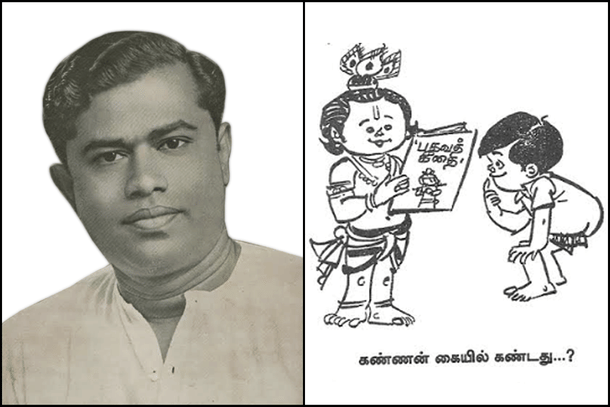
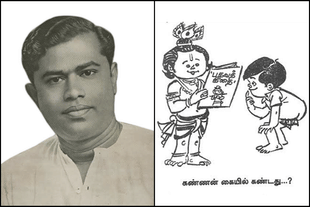
Rama was born on Navami day
It was a sparkling sunny day;
Krishna was born on Ashtami night
And that too dark and a stormy night!
Born in a palace Sri Rama
All Ayodhya celebrated glad
Krishna was born in a prison dungeon
Only witnesses his mother and dad ...
So, goes a very famous Bhajan-cum-children’s song in Tamil Nadu. The song goes on pointing out the differences between Sri Rama and Sri Krishna. And the song ends, asking the children never to forget Sri Rama whose life sets the model for us and Sri Krishna who has shown us the path through Gita.

Many Tamil kids of ‘70s and ‘80s grew up with this song.
Come Sri Ram Navami and Sri Krishna Janmashtami, the song would be enacted as dance and sung collectively as Bhajan. But not many know who wrote this wonderful song, that is one of the finest gifts a mother can bestow upon her child.
The song was written by Azha. Valliappa (1922-1989)
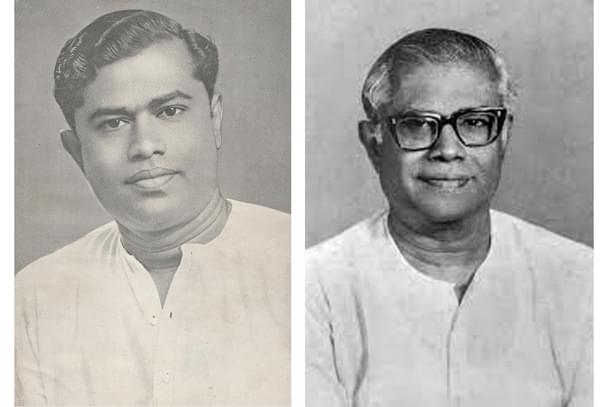
Famously known as Kuzhanthai Kavignar (poet of the children), his abundant output of poems for children catered to various age groups and in various genre.
A collection of his poems for children came out in two major volumes under the title Malarum Ullam (Flowering Mind) and then a third volume Sirikkum Pookal (Smiling Flowers).
The first edition of the first volume came in 1954 and since then it has seen many reprints. The second volume came out in the year 1961 and was as successful as the first. The third volume came in 1986 just three years before he passed away.
Even in his young age, Azha.Valliappa was attracted to Tamil poetry – particularly that of Subramanya Bharati. Valliappa was born in a village in the princely state of Puthukottai. As he grew up, he was so inspired by Bharati that he and his friends formed a Bharathi association to study and discuss his works.
One day they decided to have a procession honouring the memory of Bharati and approached the local Amman temple. Some good-hearted people of the temple management donated a silver enclosure to place the portrait of Mahakavi Bharati and then mount that on a cart pulled by bullocks.
The boys then took this around the small village shouting slogans in praise of the poet. This naturally attracted the attention of a policeman who promptly questioned the boys.
Meanwhile, people started coming and paid their respects to the poet, very similar to the way they venerated a Divinity in procession. As the boys explained to the policeman the greatness of the poet the policeman also joined the procession and the procession ended with the patriotic poems of Bharati hailing Bharat Mata.
Through various incidents in his life, Valliappa discovered his own passion and talent for writing simple yet inspiring verses for children. What he observed was that when children are told to do something with a rhyme, and rhyme with which children could connect, they did what they otherwise wouldn't do.
His own son was once refusing to eat by himself and wanted to be fed. Valliappa made a small verse ‘Cute little hands God has given, so that you can eat yourself.’ The boy repeated the verse two times and as the meaning started sinking in, he started eating himself.
Similarly, when a few children had assembled under a tree before his house, one child announced it was his birthday. A girl asked, ‘So you were born on a Monday. You are a Monday child.’ And what is special about being a Monday child another boy asked. Valliappa, listening to their conversation could not remain silent. He burst into a simple verse, ‘A child born on Monday/ Makes sure he always speaks the truth.’
Now another child wanted to know what about a Thursday child. Soon for every day of the week a virtue was assigned. A few days later his son asked him for a quarter paise because the next day the school was going to celebrate Sri Ramakrishna Jayanti. Casually Valliappa said, ‘really?’ The boy at once retorted ‘Am a Monday child father. A child born on Monday/ Makes sure he always speaks the truth.’
Valliappa realised that with his talent he could make a difference in terms of value-inculcation in the lives of generations of children.
In writing such value-inculcating, sweet, simple yet profoundly deep poems for children, he had an Acharya. His Acharya was Kavimani Desiga Vinayakam Pillai (1876-1954). Many scholars consider Azha.Valliappa as belonging to Kavimani school of children literature.
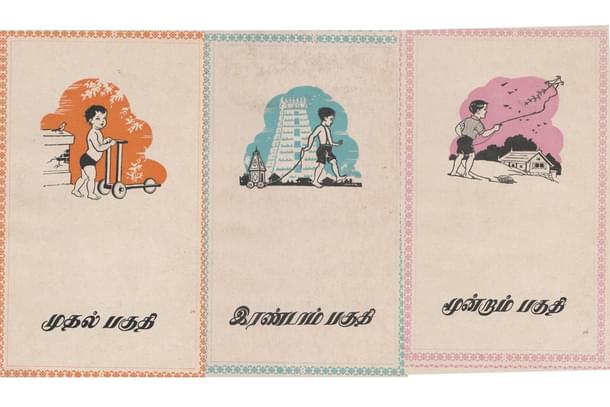
In his Malarum Ullam, he employed an interesting methodology.
The book was divided into sections based on the developmental stages of the child. These stages shown in the book have a distinct Indian characteristic and have nothing to do with Western psychological categories like that of Jean Piaget. This is a pointer as to how we can work out our own methodology to reach children.
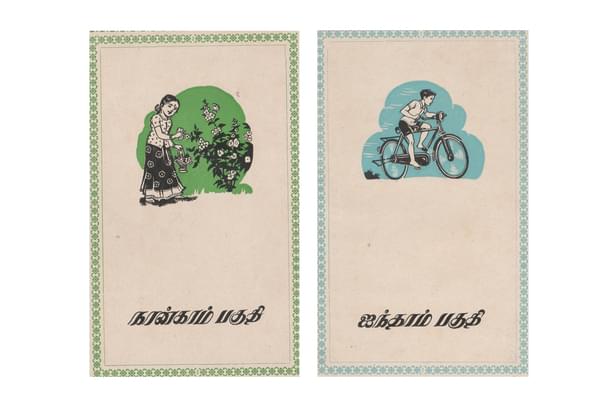
In all his poems he emphasised Bhakti for the Gods and Goddesses, establishing a loving relation, love for the nation, compassion for all life, non-violence and truth. A strong Gandhian, his work on the entire life of Mahatma Gandhi, in the form of poem that children can easily memorise, is considered a milestone in Tamil children's literature.
Azha.Valliappa had a great love for Kannan (Krishna) and Murugan (Skanda). In one of his poems for children he describes a child describe her siblings: There are four children in our home she says. Two being herself and her brother. Then the other two? They are these two Divine Children in their Puja room.

As said earlier, the poem comparing Krishna and Rama is sung today in many Bhajans and many mothers teach their children this poem.
Another famous song he wrote on Sri Krishna is Kannan engal Kannananam, (Krishna our own Krishna). This too has become so famous that many even today think it is a folk song.
The poem takes the child through the various divine adventures of Krishna. He ate the butter as well as the sand. He played the flute and gathered together the cows. He saved the cowherds from a storm by making an umbrella out of the mountain. He subdued the poisonous serpent and killed the tyrannical Kamsa. He walked as peace emissary for the Pandavas. He blessed us with the Gita in the battlefield.
Beautifully rhyming words filled with sweetness of Bhakti, the poem has defined for Tamil children their love for Krishna.
Entering into a loving relation with Krishna cannot be accomplished by mere discourses or at the intellectual level. It cannot be accomplished by making our children watch Computer Graphics filled Puranic serials. It cannot be done by teaching them hymns alone. That relation should enter the child through a complete environment.
Azha.Valliappa provided that for both the child and the mother. When a mother sings these aspects of Krishna, the child is introduced to a relation of a friendship with Him.
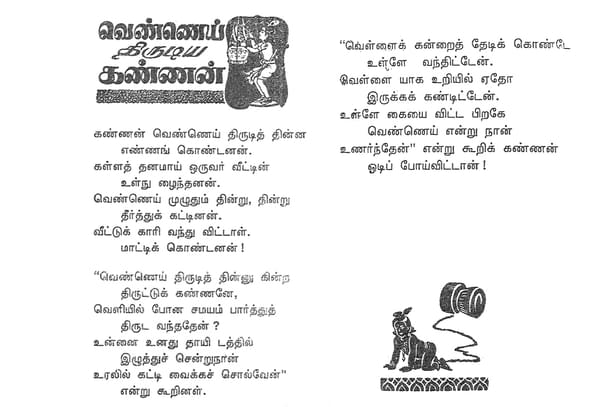
So another poem speaks of how Krishna was caught red-handed when stealing butter and how he wriggled out by telling he was searching for the white calf and mistook the butter in the pot for the calf.
At the same time He is also the teacher of highest Truth. His trickster persona may hide that. But look carefully, lovingly, and intensely, and you will find that He has in His hands the immortal Truth.

In another poem Krishna comes hiding something in His hand. The curious little boy makes a lot of efforts and after some time discovers it to be the Bhagavad Gita - 'that book of highest order that proclaims the Truth Bhagavad Gita I found!' exclaims the boy.
Encoded in the deceptively simple beauty of his poems exists a great value system and a spiritual heritage to be discovered. None other than the legendary K.R. Srinivasa Iyengar (1908-1999) translated a simple rhyme-poem.
What's this God-given hand for?
For gathering food and eating it.
...
What's this God-given hand for?
For writing fair and for reading.
...
What's this God-given hand for?
For rendering service to others.
What's this God-given hand for?
For ardent worship of the Lord.
Then Prof. K.R.Srinivasa Iyengar decoded it:
These seven hills of ascent, from the material to the spiritual, from Annamaya to Anandamaya, comprehend the whole philosophy of useful and wise living, and the child learns it with a lilt and no trace of tears. ... Contrary to the usual assumption that one who writes for children should 'stoop' to their level, it is actually a question of rising to THEIR much higher and purer levels of consciousness.
In another poem is from the point of view of a little girl, who speaks of how she would string together flowers for Krishna:
Flowers with colours manifold
and varied fragrances;
they give me their smiles,
my dear sweet flowers.
Sapphire, green, red,
and other hues as well;
I come at daybreak and feel
enchanted by their sight
Nodding and swinging flowers,
I draw near to pluck them
and fill my basket
and the flowers smile!
They smile as I view them,
and also as I pluck them;
and they smile on when I
weave of them a garland.
For Krishna's image,
I've made this garland;
and like my younger brother,
it smiles at me.
After the translation of the entire poem Iyengar points out how this initiates the child into a loving relation with flowers.
The Mother of the Pondicherry Sri Aurobindo Ashram always emphasised:
Be like a flower ... open, frank, equal, generous and kind. ... A flower is open to all that surrounds it. ... It exerts a spontaneous influence on all that is around it. It radiates a joy and a beauty. It is frank; it hides nothing of its beauty, and lets it flow; frankly out of itself ... It is equal: it has no preferences ... Then generous ... It sacrifices entirely for our pleasure. And then kind: it has such a tenderness. Its presence fills with joy...
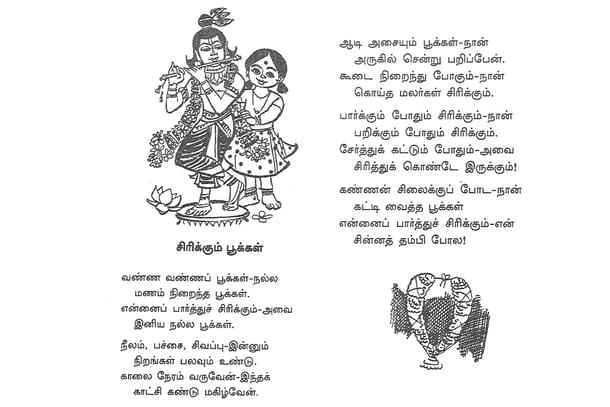
Valliappa also wrote stories for children. He used to collect the interesting incidents that happened in the childhood lives of great personalities from across the world and present it to children.

From Helen Keller overcoming her physical challenges to Albert Einstein overcoming anti-Semitism he faced in his classroom to Lal Bahadur Shastri learning the responsibility of growing up as a child who had lost his father to how child Mohan overcame his fears with Ram Nam – the book contained a variety of personalities.
The book allows a child to build his or her inner strength and accept his or her own uniqueness.
Valliappa was the member of Madurai Kamaraj University senate. When he was once giving a speech to the members on the importance of having child literature as a subject in the university he fainted and fell down. And he breathed his last on March 16, 1989.
This is his birth centenary year and on the occasion of India’s truer National Children’s Day that is Sri Gokulashtami, Sri Krishna Jayanthi let us remember this great devotee of Krishna as well as great teacher of children and a national architect of children’s literature.
Aravindan is a contributing editor at Swarajya.





